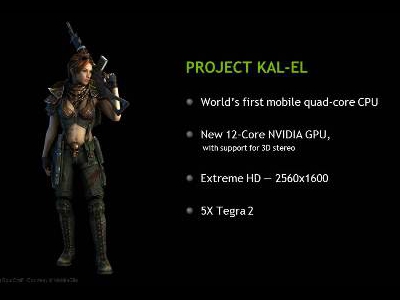Nvidia's Tegra Kal-El Will Be 40 nm, Not 28 nm
Kal-El won't receive the 28 nm treatment, but Wayne will get to don the new tech next year without having to punch any villains.
During a conference call with financial analysts, Nvidia CEO Jen-Hsun Huang indicated that the upcoming Tegra "Kal-El" system-on-chip will be manufactured using the 40 nm process technology. This is seemingly due to Taiwan Semiconductor Manufacturing Company's (TSMC) inability to provide the required volume of 28nm chips to support the Kal-El launch in Q3 2011.
"28 nm is not available this year, not until the very end of the year," said Jen-Hsun Huang. "I think, for us to ship [Tegra "Kal El"] production out in Q3, we have to start wafers in early Q2, right? So, 28 nm is not an option. Secondly, 40nm is now in the third year of its production, and the yields are fabulous. [...] So 40nm process technology is absolutely the right approach. It is the most mature, and we can go into very high [volume] production very quickly because the yields are so great."
Revealed Tuesday during Mobile World Congress 2011, Nvidia's Kal-El SoC features a four-core processor and an additional 12-core GeForce GPU. It is also capable of running 1440p video content on a 2560 x 1600 panel, and has enough horsepower to generate a Retina display-like 300 DPI image on a 10-inch tablet. Kal-El's overall power consumption won't be greater than the current Nvidia SoC, Tegra 2.
During the call, Huang said that the SoCs following Kal-El will likely use the 28 nm manufacturing, noting the rhythm in how quickly the industry changes processing. "You have noticed other companies that have used different ways of explaining their rhythm and some use one process node change," he explained. "One as a architecture change, the next one is the process node change. Basically, it is every other year for a new process node. I think that rhythm is not a bad rhythm. I mean, that is basically how quickly the industry is changing process. So [this is] the reason why Tegra 2 and Tegra 'Kal-El' will use the same process, and then the following ones would be 28 nm."
Huang added that 40nm would actually be more economical than 28 nm this year. "We will likely expect it to be so until about first half, maybe even the midpoint of next year," he said.
Morris Chang, chairman and chief executive officer of TSMC, previously indicated that chips using 28 nm high-K metal gate process technology would start to ramp in Q3 2011 and then increase even more in Q4. "We plan to have around 2-percent or 3-percent of our total revenue in the fourth quarter be [from] 28 nm. But the real momentum [for 28nm], we believe, will be next year," Chang said.
Get Tom's Hardware's best news and in-depth reviews, straight to your inbox.

Kevin Parrish has over a decade of experience as a writer, editor, and product tester. His work focused on computer hardware, networking equipment, smartphones, tablets, gaming consoles, and other internet-connected devices. His work has appeared in Tom's Hardware, Tom's Guide, Maximum PC, Digital Trends, Android Authority, How-To Geek, Lifewire, and others.
-
casperstouch Can we put the Kal-El in the Atrix phone, and market on the T-Mobile network. When they do I will be the first in line.Reply -
ares1214 dark_knight33Wayne? Don't you mean "Kent"?HansVonOhainLol at Wayne part. Proof read next time, please. I love this site.Reply
Both you 2 should proof read a little. Hes refering to the next CPU after Kal El being called Wayne:
http://www.anandtech.com/show/4181/nvidias-project-kalel-quadcore-a9s-coming-to-smartphonestablets-this-year
I love peoples stupidity... -
illo HansVonOhainLol at Wayne part. Proof read next time, please. I love this site.Reply
i think the best part about this site is the contradictory, misinformation and poor spelling in articles. -
dark_knight33 Perhaps if the writing errors weren't so prevalent here, I might have considered that Wayne was referring to something else. As it is, you can hardly blame us. BTW, it's a SoC, not (only) a CPU, +1 for misuse of "proof read" though.Reply
I love the stupidity of quoted replies... -
These chips are getting pretty good now. I wonder how long till they can match a C2 Duo 8800gt pc.Reply
-
nottheking This holdup on 40nm is hurting us all, I think. TSMC should be ashamed for scrapping their old 32nm plans, leaving nVidia (along with AMD and many other companies) stuck having to cope with 40nm but still being necessitated to keep pushing out newer and more powerful designs. 'course, I may be wrong: the limitations may be now pushing them to re-design to make more of less, which could pay off in the end: we'll have to see once this thing finally arrives.Reply
